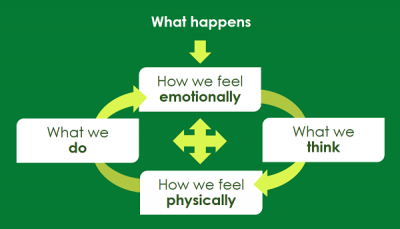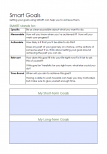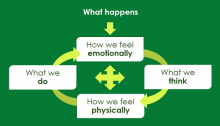Patient Area
1. Getting Started
Here you'll find all the worksheets and information you'll need to accompany your learning for Session 1 of our Managing Moods webinars.
What we learned this week
How our thoughts, feelings and actions are linked

We introduced the "5 Areas" model from Cognitive Behavioural Therapy (CBT). This shows the links between what we think, how we feel both mentally and physically, and what we do. These links can become a 'vicious cycle' that lead to symptoms of depression or anxiety.
In Managing Moods, we aim to equip you with the skills to break your vicious cycles, and feel more like you again.
How vicious cycles can lead to symptoms of depression and anxiety
We explored symptoms of depression and anxiety. Although everyone's experience is different, we're not alone. We all attend Managing Moods because we experience some similar symptoms, even if they affect us in different ways.
Video: I had a black dog
How it's not all in the mind
We looked at the role of adrenaline in the body. We noticed that physical symptoms of anxiety and stress can be similar to how our body feels when we're excited about something fun, or doing a good workout.
Later in the course, we'll teach some relaxation techniques to help reduce these physical symptoms. For now, we understand where these symptoms come from, and that they will pass.
How we can look after our mental wellbeing just like we look after our physical wellbeing
We discovered the 5 Ways to Wellbeing, a set of simple ways to look after our mental wellbeing, just like getting our 5 portions of fruit & veg to look after our physical wellbeing.
Link: How to do the 5 Ways to Wellbeing from home
How our Employment Advisors can help with issues at work
We introduced our Employment Support team, who can help you to tackle issues at work. If your work is affecting your mental health, or your symptoms are affecting your work, contact us to be linked with an Employment Advisor.
If you're not currently employed, you may find the National Careers Service helpful instead.
What other support is available
We looked at the value of peer support, and where we can go to connect with others who have had similar experiences.
Links:
- Side by Side, a supportive online community run by Mind.
- Solent Mind's wellbeing centres, with a wide range of support available across Hampshire. .
Actions
A popular saying with attendees of our Managing Moods course is "you get out what you put in", because we can equip you with the tools, but how you put them into practice is what makes the difference.
Each week we'll share a few ways you can start using what you've learned.
This week's actions:
- Fill in your own "5 Areas" worksheet (below)
- What are your vicious cycles?
- Set some goals
Tip: Writing these down can help you to stay motivated and see the progress you're making.- What do you want to get out of these sessions?
- How will you know when you've reached your goals?
- Explore the 5 Ways to Wellbeing
Tip: It may help to make a note of what you try, to see how the 5 Ways contribute to your goals.- Which of the 5 Ways are you already doing?
- Could you get a better balance of all 5 in your lifestyle?
 Menu
Menu




